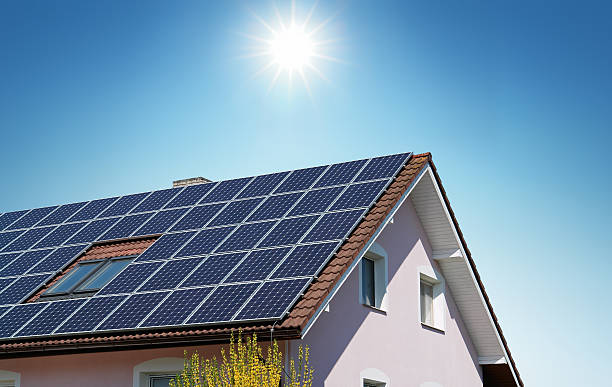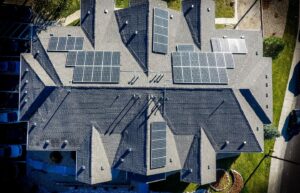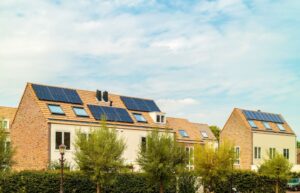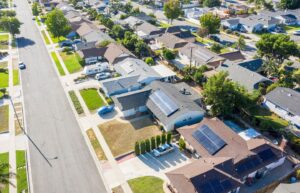Solar panels, also known as photovoltaic cells, are the unsung heroes of clean energy. These revolutionary PV cells are transforming the way we generate usable electricity to power our world, but how do solar panels really work? Harnessing the boundless energy of sunlight, solar technologies, such as photovoltaic cells, have become a vital component in the quest for sustainable and renewable electricity.
Understanding the inner workings of solar panels is crucial for unlocking their full potential in generating thermal power and maximizing their efficiency in supplying usable electricity to the power grid. This knowledge is essential for meeting the ever-increasing electricity needs of our society.
Read on as we explore how Solar by Peak to Peak can bring sustainable energy solutions to your doorstep.
Unveiling the Inner Workings of Solar Panels

Solar panels are fascinating devices that harness the power of the sun to generate electricity and heat. They are also used in advertisements to provide information about hot water.
Multiple Interconnected Solar Cells
At their core, solar panels are comprised of multiple interconnected solar cells that harness heat and generate electricity for the home. This information is important for anyone considering investing in solar panels as a cost-effective and sustainable energy solution. Unlike traditional forms of energy, solar power does not rely on advertisements to promote its benefits.
These individual cells, powered by solar technology, work together to convert solar radiation into usable electrical energy. This is how solar power works using innovative solar technologies. Each solar cell is made up of semiconductor materials, most commonly silicon-based, which possess unique properties that enable them to absorb photons from solar radiation. Solar technology utilizes these cells in solar energy systems and technologies.
The Role of Materials in Efficiency and Performance
The choice of materials used in solar cells greatly impacts their efficiency, overall performance, and home advertisement. Silicon-based solar cells are widely utilized for their effectiveness and availability in both home and commercial applications. These cells are often used to power homes, making them an ideal choice for those looking to reduce their energy bills.
Additionally, the advertisement of these solar cells has increased their popularity among homeowners. There are two main types: monocrystalline and polycrystalline. Monocrystalline silicon cells, a type of solar technology, consist of a single crystal structure, while polycrystalline silicon cells, another type of solar energy technology, contain multiple crystal structures.
Arrangement of Layers for Conversion
Within each home solar cell, there is a specific arrangement of layers that facilitates the conversion of light into electricity. The top layer of solar energy systems consists of metal plates or grids that allow sunlight to pass through while also collecting the generated electrons. These solar energy technologies are commonly used in homes. Under this layer lies a thin sheet known as an anti-reflective coating, which minimizes reflection and maximizes light absorption in solar energy technologies.
The Magic Happens at the P-N Junction
The heart of a solar cell lies at the p-n junction—the interface between two different types of silicon layers within the cell. The top layer of the solar energy device is doped with phosphorus atoms, creating an excess of electrons (n-type), while the bottom layer is doped with boron atoms, resulting in a deficiency (p-type). This creates an electric field at the junction.
When photons strike this p-n junction, they transfer their energy to electrons in the n-type region, freeing them from their atoms. The electric field then drives these electrons towards the p-type region, creating a flow of current powered by solar energy. This is where the conversion of light energy to electrical energy occurs.
The Role of Inverters and the Grid
For use in homes and businesses, solar panels must convert the direct current (DC) they produce into alternating current (AC). Inverters play a crucial role in converting solar energy from DC power into AC power that seamlessly integrates with the existing electrical grid.
Once the electricity has been converted, it can either be used immediately or fed back into the grid for others to utilize. In some cases, solar panels excess energy output during periods of intense sunlight can even result in credits on your electricity bill, which is advantageous for both you and the environment.
Understanding how solar panels work provides valuable insight into their effectiveness and benefits. By harnessing the power of sunlight, these remarkable devices offer an eco-friendly alternative to traditional energy sources while reducing reliance on fossil fuels.
The Photovoltaic Effect and Solar Cell Function
The photovoltaic effect is the key process for solar panels to generate electricity. It’s all about converting sunlight into usable energy. So, how does it actually work? Let’s break it down.
When photons (particles of light) strike a solar cell, they have enough energy to knock loose electrons from the atoms within the material of the cell. This phenomenon is known as the photovoltaic effect. In simpler terms, it’s like a game of billiards where the photons are the cue balls and the electrons are the target balls.
As these electrons are freed from their atoms, they start moving around within the material of the solar cell. The movement creates an electric current—a flow of electrons—which produces direct current (DC) electricity within the cell itself. This electrical current is where all our solar power starts!
But wait, there’s more! A single solar cell on its own can only generate a small amount of electricity. To harness more power, multiple solar cells are connected together to form what we commonly refer to as a module or panel.
These interconnected cells work together in harmony to produce a larger amount of usable electricity. Think of it like teamwork: each individual player (a solar cell) contributes their part to achieve a common goal (generating electricity).
Now You Might Be Wondering: What Exactly Happens Inside These Individual Solar Cells?
Each solar cell consists of layers made primarily of silicon, a semiconducting material. These layers create an electric field within the cell that helps facilitate electron movement when struck by photons.
The top layer is usually treated with phosphorus atoms, which add extra electrons to create an excess negative charge. Meanwhile, the bottom layer contains boron atoms that result in a deficit or lack of electrons, creating a positive charge.
This difference in charges between layers sets up an electric field within the cell. When light hits the cell, it excites the electrons in the top layer, allowing them to break free and move towards the bottom layer.
This movement of electrons creates an electric current that can then be captured and utilized for various applications. By connecting multiple solar cells together, we can generate even more electricity to power our homes, businesses, and communities.
Converting Sunlight into Electrical Energy
The process by which solar panels really work is fascinating. It all starts with sunlight, which consists of tiny packets of energy called photons that carry electromagnetic radiation. When these photons strike the surface of a solar cell, they transfer their energy to electrons within the material.
This transfer of energy from photons to electrons energizes the electrons, allowing them to break free from their atoms and move more freely. As a result, an electric current is created within the solar cell. This electrical current can then be harnessed and used as solar electricity to power various devices and meet our electricity needs.
The conversion of sunlight into usable electrical energy happens due to a phenomenon known as the photovoltaic effect. Through this effect, solar cells are able to generate electricity by utilizing the properties of certain materials, such as silicon.
To understand this process better, let’s break it down step by step:
Sunlight Consists of Photons
Sunlight contains countless photons that carry electromagnetic radiation. These photons travel from the sun and reach our planet in vast quantities every day.
Photons Transfer Energy to Electrons
When sunlight reaches a solar panel, the photons interact with the atoms in the material. This interaction causes the transfer of energy from the photons to the electrons present in the material.
Energized Electrons Create an Electric Current
As these energized electrons gain sufficient energy from the transferred photons, they become free to move around within the material. This movement creates an electric current or flow of electric charge.
Conversion of Sunlight into Usable Electricity
Once an electric current is established within a solar cell, it can be utilized for various purposes. Solar panels can either produce direct current (DC) electricity for later use or convert it into alternating current (AC) using inverters for immediate use.
Solar electricity generated through this process provides a clean and renewable source of energy. It helps reduce our reliance on fossil fuels and contributes to a more sustainable future.
Solar panels are designed to harness sunlight efficiently and convert it into usable electrical energy. They consist of multiple solar cells connected in series or parallel to increase the overall power output. This enables them to generate sufficient electricity to meet our daily needs.
Debunking the Myth of Cloudy Day Inactivity
Solar Panels can Still Generate Electricity on Cloudy Days, Although at Reduced Efficiency
Contrary to popular belief, solar panels are not rendered completely useless on cloudy days. While it’s true that their efficiency is reduced when compared to bright, sunny days, they can still generate electricity. Even with diffuse light from the clouds, solar cells are capable of activating the photovoltaic effect and converting sunlight into electrical energy.
The Diffuse Light on Cloudy Days can Still Activate the Photovoltaic Effect in Solar Cells
Solar panels rely on the photovoltaic effect to produce electricity. This process occurs when sunlight interacts with the semiconductor material within the solar cells. The photons from the sun’s rays excite electrons in the semiconductor material, causing them to flow and create an electric current. Even on cloudy days, where direct sunlight is not readily available, there is still enough diffuse light for this process to occur to some extent.
Solar Panels Continue to Produce Power Even When Direct Sunlight is Not Available Due to Cloud Cover
Cloud cover may block a significant portion of direct sunlight from reaching solar panels, but it does not render them completely inactive. The panels can still capture and convert the available light into usable energy. While their output may be lower during cloudy weather conditions, they remain functional enough for practical use. It’s worth noting that different types of solar panel technologies have varying degrees of efficiency under low-light conditions.
The Overall Output May Be Lower During Cloudy Weather, But it Remains Significant Enough for Practical Use
It’s important to understand that while solar panels do experience reduced efficiency on overcast days, they can still contribute a significant amount of power generation. Their ability to continue producing electricity even under less-than-optimal conditions makes them a reliable source of renewable energy. For example, in regions with frequent cloud cover or areas where sunshine hours are limited throughout the year, solar installations are still viable and can make a meaningful impact on energy production.
Solar Power as a Clean and Reliable Energy Source
Solar power has emerged as a game-changer in the quest for clean and reliable energy sources. With its ability to harness the sun’s energy, solar power offers numerous benefits that make it an attractive option for sustainable power generation. Let’s take a closer look at how solar panels really work and why they have become such a popular choice.
Clean and Renewable Energy Sources
One of the most significant advantages of solar power is its status as a clean and renewable energy source. Unlike fossil fuels, which release harmful greenhouse gas emissions into the atmosphere when burned, solar energy produces no such pollutants. This makes it an environmentally friendly alternative that helps reduce our carbon footprint and combat climate change.
Minimal Maintenance Requirements
Another key benefit of solar panels is their minimal maintenance requirements. Once installed, they generally require very little upkeep, making them a reliable long-term energy solution. Unlike traditional power plants that often need regular repairs or maintenance checks, solar panels can continue generating electricity with minimal intervention.
Consistent and Sustainable Power Generation
Solar power relies on the abundance of sunlight to generate electricity. As long as there is daylight, solar panels can convert sunlight into usable energy. This consistent source of power ensures sustainability by meeting our energy needs without depleting finite resources like fossil fuels.
Reducing Dependence on Fossil Fuels
By harnessing the sun’s energy, solar power plays a crucial role in reducing our dependence on fossil fuels. The more we rely on renewable sources like solar energy, the less we rely on traditional methods of generating electricity that contribute to air pollution and climate change. Solar power offers an opportunity to transition towards cleaner forms of energy production.
Mitigating Climate Change
The adoption of solar technology has significant implications for mitigating climate change. By shifting towards renewable sources like solar power, we can decrease greenhouse gas emissions, which are major contributors to global warming. Solar energy technologies offer a sustainable and eco-friendly alternative to conventional thermal power plants, helping us combat the adverse effects of climate change.
Utilizing Solar Panels in Residential Settings
Installing solar panels on rooftops is a game-changer for homeowners who want to take control of their energy consumption. By harnessing the power of the sun, these panels allow homeowners to generate their own electricity and reduce their reliance on traditional utility companies.
Storage of Excess Solar Energy
One of the key benefits of installing solar panels is the ability to store excess solar energy. When your solar panels produce more electricity than you need, that surplus energy can be stored in batteries or fed back into the grid for credit. This means that even on cloudy days or at night, you can still access the stored energy and power your home without interruption.
Financial Incentives Offered by Local Government and Federal Agencies
Financial incentives have made residential solar installations more affordable than ever before. Homeowners can take advantage of tax credits offered by local governments or federal agencies, reducing the upfront costs associated with installing solar panels. Net metering programs allow homeowners to receive compensation from utility companies for any excess electricity they feed back into the grid.
The long-term financial benefits of using solar panels are substantial. While there is an initial investment required for purchasing and installing the system, homeowners can significantly reduce their electricity bills over time. With solar panels generating clean and free energy from the sun, households can save hundreds or even thousands of dollars annually on their utility bills.
Environmental Sustainability
Moreover, using solar panels also contributes positively to environmental sustainability. By relying on renewable energy sources like sunlight instead of fossil fuels, homeowners actively participate in reducing greenhouse gas emissions and combating climate change. This environmentally friendly choice benefits individuals and has a collective impact on creating a cleaner and greener future for all.
In recent years, advancements in solar technology have made it easier than ever for homeowners to transition to clean energy solutions. There are now numerous reputable solar panel installers and companies offering a range of options tailored specifically for residential settings. From small-scale systems designed for individual homes to larger installations suitable for multi-family dwellings or communities, there is a solar solution to fit every need.
Experience the Future of Energy Generation: Solar from Peak to Peak
Solar by Peak to Peak is at the forefront of providing state-of-the-art solar panel solutions for residential and commercial applications. Our advanced technology is designed to maximize the efficiency and performance of solar panels, allowing customers to transition to clean and sustainable energy sources seamlessly.
State-of-the-Art Solar Panel Solutions
At Solar by Peak to Peak, we pride ourselves on offering cutting-edge solar panel solutions tailored to meet our customers’ unique needs. Our team of experts utilizes the latest advancements in solar technology to ensure that our panels are highly efficient and reliable.
With our state-of-the-art solar panels, you can harness the power of the sun and convert it into usable electricity for your home or business. These panels are equipped with high-quality photovoltaic cells that efficiently capture sunlight and convert it into direct current (DC) electricity.
Seamless Transition to Clean Energy
With Solar by Peak’s expertise in solar panel solutions, you can seamlessly transition to clean and sustainable energy sources. By generating your own electricity from the sun, you can significantly reduce your reliance on fossil fuels and contribute to a greener future.
Not only will you be reducing your carbon footprint, but you’ll also enjoy long-term cost savings. Solar energy is a renewable resource that is freely available, allowing you to lower your monthly utility bills and earn credits for excess energy produced through net metering programs.
Embrace the Future of Energy Generation
Solar by Peak to Peak invites you to join us in embracing the future of energy generation. With our cutting-edge solar solutions, you can experience the benefits of clean and sustainable power while making a positive impact on the environment.
Say goodbye to rising electricity costs and hello to a more efficient and eco-friendly way of powering your home or business. Contact Solar by Peak to Peak today, and let us help you harness the power of the sun!
How Do Solar Panels Really Work?
You now have a solid understanding of how solar panels really work. We’ve delved into the inner workings of these incredible devices, exploring the photovoltaic effect and how it converts sunlight into electrical energy. We’ve debunked the myth that solar panels are only effective on sunny days, highlighting their reliability even in cloudy weather. Moreover, we’ve discussed the environmental benefits of solar power as a clean and sustainable energy source.
Consider harnessing the power of the sun by incorporating solar panels into your residential setting. Can you Imagine being able to generate your own electricity while minimizing your carbon footprint? It’s like having your own personal power station right on your rooftop!
Ready to make the switch to clean energy? Contact Solar by Peak to Peak today to learn how you can power your home or business with the sun’s energy. Embrace a greener, more sustainable future now!




